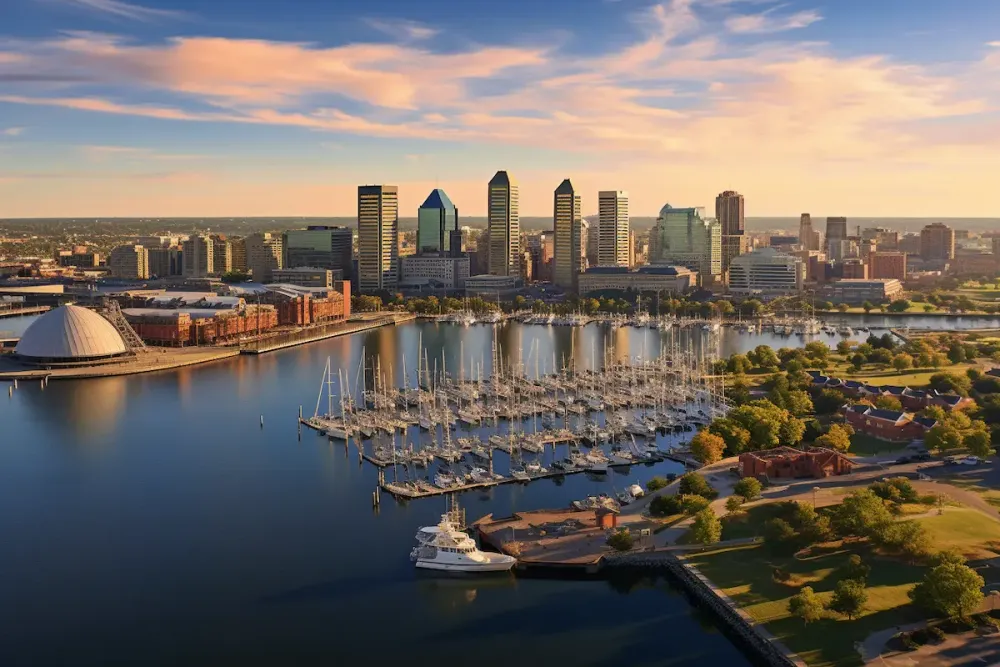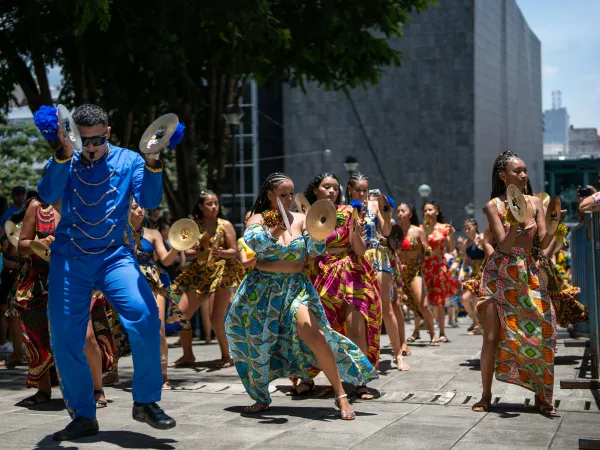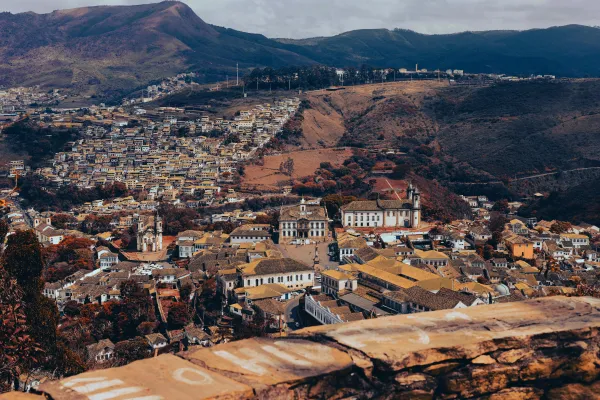16 Unbelievable Things To Do In Inner Harbor You Have To Experience
Few places embody Baltimore’s spirit as completely as the Inner Harbor. Once a bustling 18th- and 19th-century seaport, it was the heart of the city’s economy, connecting Maryland to global trade in tobacco, grain, and shipbuilding. By the mid-20th century, however, the harbor had fallen into decline as shipping moved elsewhere, leaving warehouses and piers abandoned.
In the 1970s and 1980s, Baltimore undertook one of the most ambitious urban renewal projects in the United States, transforming the Inner Harbor into a vibrant hub of culture, tourism, and community life. This revival became a national model, showing how cities could breathe new life into their waterfronts and reclaim them as spaces for people rather than industry.
Today, the Inner Harbor is both a historical landmark and a lively destination. Visitors can stroll along the waterfront, step into world-class museums, climb aboard historic ships, or simply enjoy the skyline views. With its mix of history, entertainment, and family-friendly attractions, the harbor symbolizes Baltimore’s resilience and creativity.
In this guide, we explore the best things to do in Inner Harbor, Baltimore, providing a curated list that promises an enriching and pleasurable experience while here.
1. Baltimore Visitor Center
Important Information
- Address: 401 Light Street, Baltimore, MD 21202
- Best time to visit: Year-round; best in spring and summer during festivals and waterfront events.
- Distance to city center: Located directly in the Inner Harbor.
- Pricing: Free entry.
- Parking: Nearby public garages and metered street parking.
- Accessibility: Fully accessible.
- Opening Hours: Daily, 10 a.m.–5 p.m.
- Closing Hours: 5 p.m.
- Discounts / Deals: Free maps, brochures, and coupon booklets for attractions.
The Baltimore Visitor Center, located right on the waterfront at the Inner Harbor, is the perfect gateway to understanding the city. More than just a place for maps and brochures, the center represents Baltimore’s effort to reintroduce itself to the world after decades of decline in the 20th century. Opened in 2004, its sleek glass-and-steel design reflects the modern renaissance of the Inner Harbor—a space meant to welcome travelers while showcasing Baltimore’s deep roots in American history.
Inside, you’ll find interactive exhibits and knowledgeable staff ready to guide you through the city’s diverse attractions—from maritime heritage to African American history, from cutting-edge science museums to iconic sports venues. It’s also a place where Baltimore’s story is told as part of the larger American narrative: a port city that weathered industrial booms and busts, social change, and cultural rebirth.
Beginning here gives visitors the context they need to fully appreciate the harbor and beyond. It’s the launching point for discovering how Baltimore evolved from a colonial seaport into a modern city that still proudly carries its historic character.
2. The National Aquarium
Important Information
- Address: 501 E. Pratt Street, Baltimore, MD 21202
- Best time to visit: Weekday mornings for smaller crowds; spring/summer for full exhibits.
- Distance to city center: Inner Harbor.
- Pricing: Adults $40–$45; children $30; under 3 free.
- Parking: Discounted garage parking with validation.
- Accessibility: Fully accessible.
- Opening Hours: Daily 9 a.m.–5 p.m. (extended hours on weekends/holidays).
- Closing Hours: 5–8 p.m. depending on day.
- Discounts / Deals: Online discounts, memberships, and local promotions.
The National Aquarium, opened in 1981, was one of the cornerstone projects of Baltimore’s Inner Harbor redevelopment—and it remains one of the city’s most visited attractions. Its striking glass pavilions rising over the water are themselves symbols of rebirth, marking Baltimore’s shift from a declining industrial hub to a center of culture, science, and tourism.
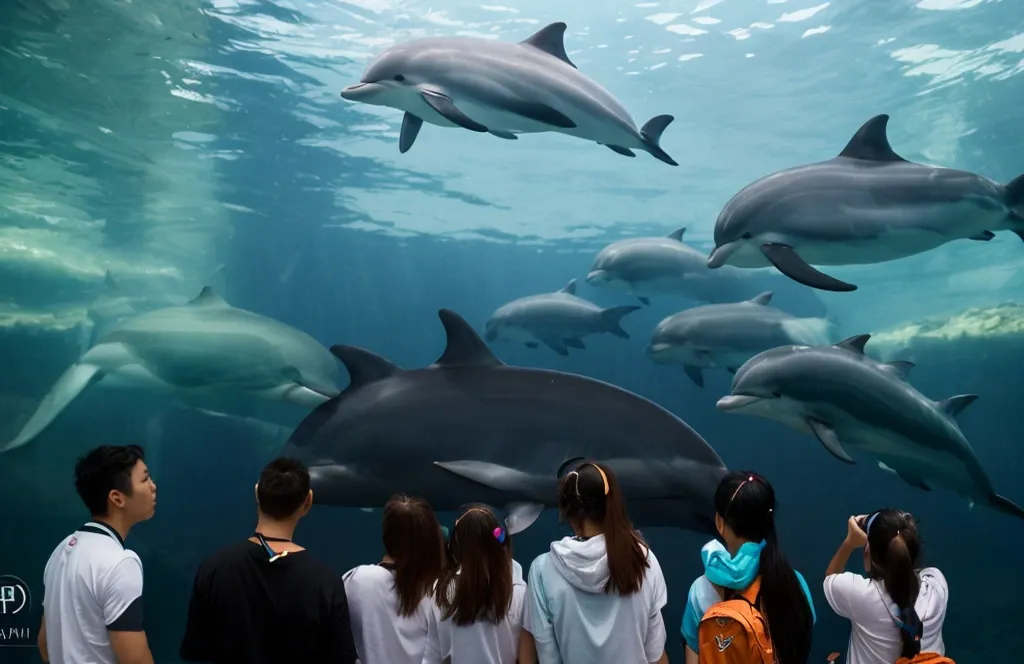
Inside, the aquarium houses over 20,000 animals across ecosystems that range from the Amazon rainforest to coral reefs and open oceans. Yet beyond its visual spectacle, the National Aquarium reflects a deeper story: America’s growing awareness of environmental conservation in the late 20th century. At a time when many cities were embracing renewal, Baltimore positioned itself at the forefront by tying its identity to education, science, and stewardship of the natural world.
Walking through the exhibits is not only a chance to marvel at sea life but also to engage with the ongoing narrative of ecological preservation—one that resonates nationally and globally. For Baltimore, the aquarium has become a defining landmark, proving that cultural investment can transform a city’s image and future.
3. Federal Hill Park
Important Information
- Address: 300 Warren Avenue, Baltimore, MD 21230
- Best time to visit: Spring and fall; summer evenings for sunsets.
- Distance to city center: About 1 mile from downtown.
- Pricing: Free.
- Parking: Street parking nearby.
- Accessibility: Some slopes steep; overlook accessible.
- Opening Hours: Sunrise.
- Closing Hours: Sunset.
- Discounts / Deals: Free entry.
Perched just south of the Inner Harbor, Federal Hill Park offers some of the most iconic views of Baltimore. But its story stretches far beyond its panoramic skyline. During the early 19th century, the hill served as a strategic lookout, especially during the War of 1812 when Baltimore was bracing against British attack. Later, in the Civil War, Union troops occupied the site to keep the city in check, recognizing its importance as both a military vantage point and a symbol of control.
Today, the cannons still standing atop the hill are reminders of those turbulent times, but the park has transformed into a beloved public space. Locals gather here for picnics, concerts, and festivals, while visitors come for the sweeping perspective that ties the historic waterfront to the modern downtown.
Federal Hill is more than just a park—it is a living monument to Baltimore’s resilience and strategic role in American history. From defending the harbor to hosting family outings, it reflects the ways cities can carry their past into their present, offering both beauty and meaning.
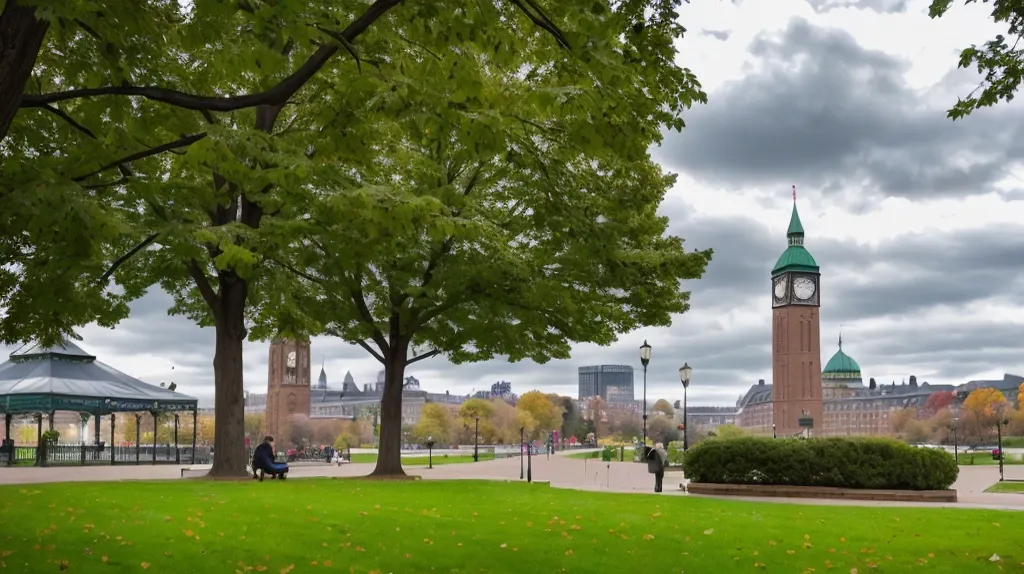
4. The Cheesecake Factory
Important Information
- Address: 201 E. Pratt Street, Baltimore, MD 21202
- Best time to visit: Lunch for quicker service; evenings for atmosphere.
- Distance to city center: Inner Harbor.
- Pricing: Entrees $15–$25; desserts $8–$10.
- Parking: Nearby garages.
- Accessibility: Accessible dining areas.
- Opening Hours: 11 a.m.–11 p.m. (weekends until midnight).
- Closing Hours: 11 p.m./12 a.m.
- Discounts / Deals: Birthday specials, gift cards, seasonal promotions.
Though a national chain, The Cheesecake Factory at Baltimore’s Inner Harbor carries local significance because of its location in Harborplace, one of the central pieces of the city’s waterfront renewal in the early 1980s. At the time, Harborplace was a groundbreaking model: an urban shopping and dining pavilion designed to bring people back downtown after decades of decline.
The restaurant itself became a staple for visitors and residents, representing the blending of Baltimore’s historic waterfront with modern American consumer culture. Sitting here with a slice of cheesecake isn’t just about indulgence—it’s about being part of the very project that helped redefine the city’s identity.
While Harborplace has faced challenges in recent years, the Cheesecake Factory remains a reminder of how national brands and local revitalization efforts often intertwine. It tells a story of how cities across America reinvented themselves in the late 20th century by embracing tourism and lifestyle culture alongside history.
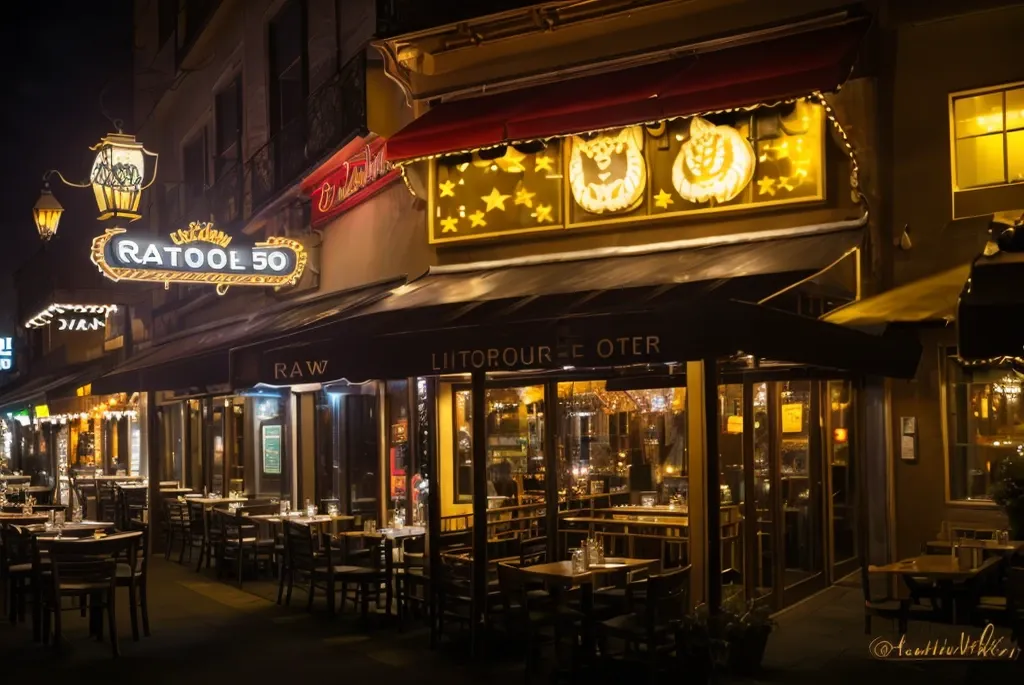
5. The Historic Ships of Baltimore
Important Information
- Address: Inner Harbor waterfront, Baltimore, MD 21202
- Best time to visit: Spring through fall; weekdays less crowded.
- Distance to city center: Inner Harbor.
- Pricing: Adults $18–$20; children $7–$9; family passes available.
- Parking: Nearby garages and street parking.
- Accessibility: Visitor center accessible; some ships limited.
- Opening Hours: 10 a.m.–4:30 p.m.
- Closing Hours: 4:30–5 p.m.
- Discounts / Deals: Student, senior, military, and group discounts.
The Historic Ships of Baltimore collection is a floating museum that ties the Inner Harbor directly to America’s naval and maritime past. Among its most striking exhibits is the USS Torsk, a World War II submarine that completed two war patrols in the Pacific and later played a role during the Cold War. Climbing aboard allows visitors to step into the cramped quarters where sailors lived, worked, and navigated history.
Alongside the submarine are other remarkable vessels: the USS Constellation, the last all-sail warship built by the U.S. Navy, and the Chesapeake, a lighthouse ship that once guided mariners safely along the coast. Collectively, these ships illustrate Baltimore’s long-standing relationship with the sea, commerce, and national defense.
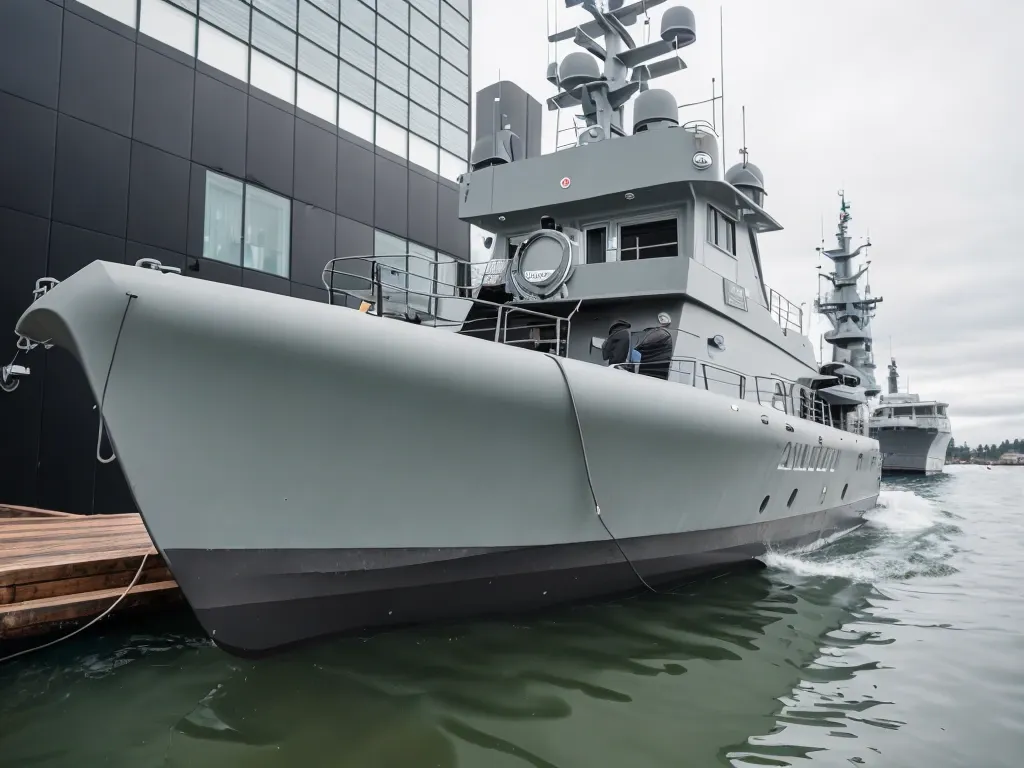
The exhibit reflects not just local pride but Baltimore’s place in the broader story of American naval innovation and maritime commerce. For visitors, walking these decks is more than sightseeing—it’s an encounter with the grit and ingenuity that shaped both the city and the nation.
6. Maryland Science Center
Important Information
- Address: Inner Harbor waterfront, Baltimore, MD 21202
- Best time to visit: Spring through fall; weekdays less crowded.
- Distance to city center: Inner Harbor.
- Pricing: Adults $18–$20; children $7–$9; family passes available.
- Parking: Nearby garages and street parking.
- Accessibility: Visitor center accessible; some ships limited.
- Opening Hours: 10 a.m.–4:30 p.m.
- Closing Hours: 4:30–5 p.m.
- Discounts / Deals: Student, senior, military, and group discounts.
The Maryland Science Center, opened in 1976, was one of the first major cultural anchors of Baltimore’s Inner Harbor redevelopment. Its presence signaled a shift in the city’s identity—from a center of industry to a hub of education, innovation, and tourism. Inside, visitors are drawn to its permanent exhibits on astronomy, space exploration, and paleontology, including life-sized dinosaur skeletons that capture the imaginations of young and old.
Historically, the center also reflects a wider American trend of the late 20th century: investing in science education as part of national progress. Baltimore’s decision to place such a museum right on the waterfront made science accessible, turning the harbor into a place not just of leisure, but of learning.
With its IMAX theater, planetarium, and interactive exhibits, the Science Center continues to inspire curiosity. But for Baltimore, it remains a cornerstone of the city’s effort to reclaim and reimagine its historic port for future generations.
7. Reginald F. Lewis Museum
Important Information
- Address: 830 E. Pratt Street, Baltimore, MD 21202
- Best time to visit: February (Black History Month) and June (Juneteenth).
- Distance to city center: Walking distance from Inner Harbor.
- Pricing: Adults $12; children $8; under 6 free.
- Parking: Nearby garages.
- Accessibility: Fully accessible.
- Opening Hours: Wednesday–Saturday 10 a.m.–5 p.m.; Sunday 12–5 p.m.
- Closing Hours: 5 p.m.
- Discounts / Deals: Free days, student/senior discounts, memberships.
The Reginald F. Lewis Museum of Maryland African American History & Culture, opened in 2005, stands as one of the most important institutions in the state. Named after Reginald F. Lewis, a Baltimore-born lawyer and businessman who became the first African American to build a billion-dollar company, the museum highlights the achievements, struggles, and enduring influence of Maryland’s Black community.
Its collections span more than 400 years, telling stories of slavery, segregation, civil rights, and cultural triumphs. For Baltimore, a city shaped by both deep inequities and remarkable resilience, the museum is more than a cultural attraction—it is a monument to voices that too often went unheard in official histories.
Placed near the Inner Harbor, the museum emphasizes the city’s commitment to telling a fuller, more inclusive story of America. It is a place where visitors can connect with the past while understanding how that history continues to shape Maryland and the nation.
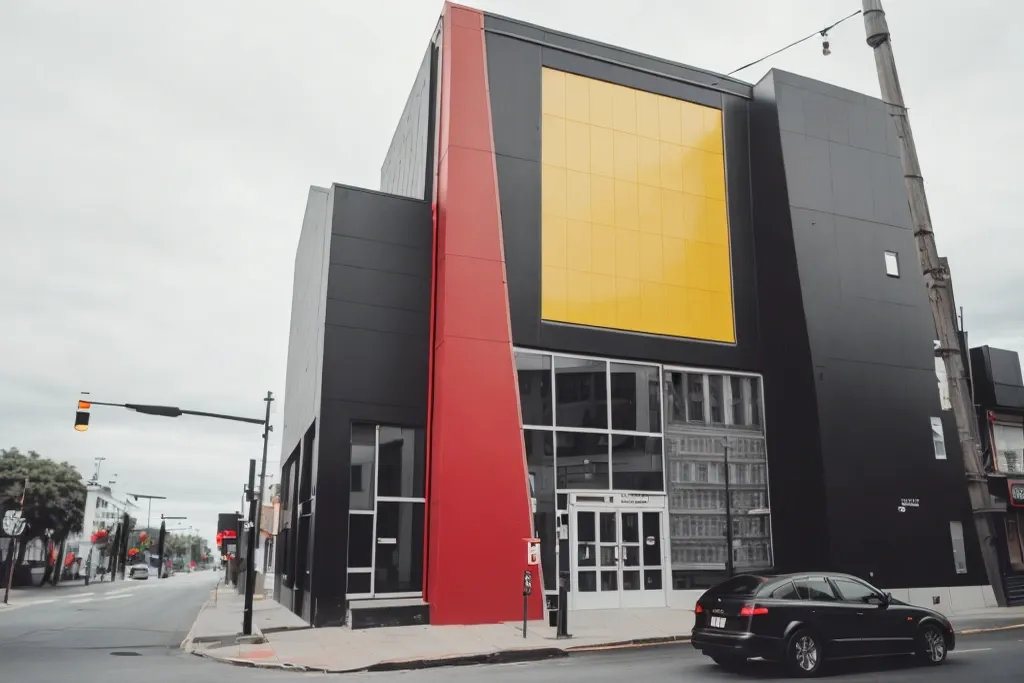
8. Inner Harbor's Pier 1
Important Information
- Address: 301 E. Pratt Street, Baltimore, MD 21202
- Best time to visit: Spring–fall for outdoor activities.
- Distance to city center: Inner Harbor.
- Pricing: Free to walk; boat rides extra.
- Parking: Paid garages and nearby meters.
- Accessibility: Wide walkways.
- Opening Hours: Morning until late evening.
- Closing Hours: Evening hours vary.
- Discounts / Deals: Free access; discounts on tours and kiosks.
On the surface, paddle boats may seem like a simple amusement, but at Baltimore’s Pier 1, they carry a deeper meaning. The whimsical dragon-shaped boats floating in the Inner Harbor are playful symbols of how a once-industrial seaport reinvented itself for recreation and public life. Where cargo ships and warehouses once dominated, families now glide across the water, experiencing the harbor in a way unimaginable a century ago.
The activity connects to Baltimore’s larger history of waterfront transformation: the idea that harbors could be for people, not just commerce. In this sense, even a fun paddle boat ride ties into the national story of urban renewal, where former working harbors became cultural and recreational landscapes.
For visitors, it’s a lighthearted way to see the skyline, feel the rhythm of the water, and literally place themselves within the city’s most historic setting. The boats may be modest, but they embody Baltimore’s creativity in blending history, leisure, and community at the Inner Harbor.
9. Port Discovery Children’s Museum
Important Information
- Address: 35 Market Place, Baltimore, MD 21202
- Best time to visit: Weekday mornings.
- Distance to city center: Less than 1 mile from Inner Harbor.
- Pricing: Adults & children $20–$25; under 1 free.
- Parking: Partner garages with discounts.
- Accessibility: Fully accessible.
- Opening Hours: Wednesday–Sunday 10 a.m.–4 p.m.
- Closing Hours: 4 p.m.
- Discounts / Deals: Group discounts, memberships, free days.
Opened in 1998 in a converted warehouse, the Port Discovery Children’s Museum embodies Baltimore’s ability to creatively repurpose its industrial past. Once part of the city’s network of shipping and storage facilities, the building now hums with laughter and learning, offering three floors of interactive exhibits designed to inspire curiosity in children.
Port Discovery reflects a broader American urban trend: transforming old industrial infrastructure into cultural assets. For Baltimore, a city that has long wrestled with reinvention, the museum demonstrates how a port once central to global trade could evolve into a hub of community and education.
With hands-on science activities, art workshops, and themed play zones, the museum engages families in ways that bridge history and imagination. By situating such a vibrant children’s space in the heart of the Inner Harbor, Baltimore ensures that its youngest visitors are connected to the city’s ongoing story of renewal.
10. American Visionary Art Museum
Important Information
- Address: 800 Key Highway, Baltimore, MD 21230
- Best time to visit: Year-round; spring/summer for outdoor art.
- Distance to city center: About 0.5 miles from Inner Harbor.
- Pricing: Adults $15–$20; discounts for seniors/students; kids under 6 free.
- Parking: Paid lot and limited street parking.
- Accessibility: Fully accessible.
- Opening Hours: Tuesday–Sunday 10 a.m.–5 p.m.
- Closing Hours: 5 p.m.
- Discounts / Deals: Student, military, senior discounts, memberships.
The American Visionary Art Museum (AVAM), opened in 1995, is one of Baltimore’s most distinctive cultural treasures. Located in former waterfront warehouses at Federal Hill, it celebrates “outsider art”—works created by self-taught artists who often exist outside traditional art institutions.
In many ways, the museum mirrors Baltimore itself: eclectic, bold, and shaped by unconventional voices. Its striking mosaic-covered exterior reflects the city’s embrace of creativity in unexpected forms, a hallmark of the Inner Harbor’s revival. AVAM has also gained national recognition, reinforcing Baltimore’s identity as a place that values individuality and artistic freedom.
The museum’s presence underscores a larger historical narrative: the 1990s movement to expand art appreciation beyond the academic elite, making it accessible and inclusive. For Baltimore, the museum is both a celebration of local culture and a contribution to a wider American conversation about what art can be and who gets to make it.
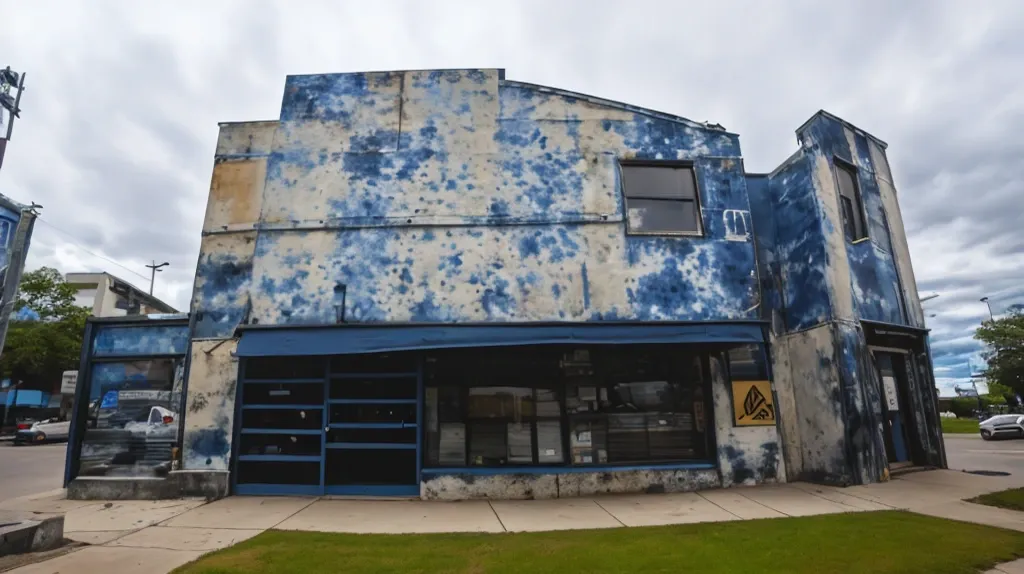
11. Power Plant Live
Important Information
- Address: 34 Market Place, Baltimore, MD 21202
- Best time to visit: Evenings/weekends.
- Distance to city center: A few blocks from Inner Harbor.
- Pricing: Free entry; cover charges for venues.
- Parking: Paid garages nearby.
- Accessibility: Accessible walkways and venues.
- Opening Hours: Late afternoon to evening.
- Closing Hours: Around 2 a.m.
- Discounts / Deals: Happy hour specials, event promotions.
Once an actual power plant built in the early 20th century, this red-brick building with towering smokestacks was reimagined in the 1990s as part of Baltimore’s push to transform its industrial relics into cultural landmarks. Today, Power Plant Live is one of the city’s top entertainment districts, hosting concerts, nightlife, and seasonal festivals just steps from the Inner Harbor.
The venue reflects a powerful theme in Baltimore’s history: adaptive reuse. Where electricity once fueled industry, now music and celebration fuel community life. The site also symbolizes the nationwide movement of reclaiming industrial spaces for arts and entertainment, turning symbols of labor into spaces of leisure.
Attending a show or festival here isn’t just fun—it’s an encounter with Baltimore’s ongoing reinvention. The preserved smokestacks stand tall as reminders of the city’s working-class roots, even as the sound of live music echoes its vibrant present.

12. World Trade Center’s Top of the World Observation Level
Important Information
- Address: 401 E. Pratt Street, Baltimore, MD 21202
- Best time to visit: Late afternoon and sunset.
- Distance to city center: Inner Harbor.
- Pricing: Adults $8; children $6; under 3 free.
- Parking: Paid garages nearby.
- Accessibility: Elevators to top floor.
- Opening Hours: Daily 10 a.m.–6 p.m. (longer in summer).
- Closing Hours: 6 p.m. or later.
- Discounts / Deals: Group, senior, and military discounts.
The Baltimore World Trade Center, completed in 1977, is the world’s tallest regular pentagonal building. Designed by the noted architect I. M. Pei, it symbolized Baltimore’s ambition to reimagine its skyline during a time when many American downtowns were struggling with decline. From its 27th-floor observation level, visitors gain sweeping views of the Inner Harbor, Federal Hill, and beyond.
Historically, the tower also reflects Baltimore’s place in international commerce. As a World Trade Center, it was intended to position the city as a global hub for business and maritime trade. In the years since, it has become a civic landmark, serving both as a commercial hub and a public destination.
Today, the Top of the World experience combines striking views with exhibits about Baltimore’s history and resilience. Standing here, visitors see not just the city’s modern beauty but the legacy of a harbor that has been at the heart of Baltimore’s story for over 300 years.

13. Baltimore Museum of Industry
Important Information
- Address: 1415 Key Highway, Baltimore, MD 21230
- Best time to visit: Weekdays; summer for waterfront views.
- Distance to city center: About 1 mile from Inner Harbor.
- Pricing: Adults $12–$15; children $7–$8; under 6 free.
- Parking: Free on-site lot.
- Accessibility: Fully accessible.
- Opening Hours: Tuesday–Sunday 9 a.m.–3 p.m.
- Closing Hours: 3 p.m.
- Discounts / Deals: Student, senior, group discounts; free days.
The Baltimore Museum of Industry (BMI) is a celebration of the city’s role as a powerhouse of American innovation. Located on a former cannery site along the waterfront, it preserves Baltimore’s history of manufacturing, shipping, and invention. Exhibits highlight industries ranging from garment-making and canning to steel, print, and radio—sectors that defined life in the 19th and 20th centuries.
Baltimore was once one of the nation’s busiest ports and a birthplace of pioneering technologies, from the first gas-powered automobile to advances in canning that fed millions. The BMI tells these stories not in abstract terms, but through recreated workshops, preserved machinery, and firsthand accounts from the workers who shaped the city.
Visiting the museum offers a rare chance to step back into Baltimore’s industrial golden age and understand how its labor force powered not only the local economy but also broader American progress. Today, the BMI also serves as a reminder of the resilience and ingenuity that still define Baltimore’s spirit.
14. Harborplace Mall
Important Information
- Address: 200 E. Pratt Street, Baltimore, MD 21202
- Best time to visit: Weekends/evenings.
- Distance to city center: Inner Harbor.
- Pricing: Free entry; shops/restaurants vary.
- Parking: Paid garages nearby.
- Accessibility: Fully accessible.
- Opening Hours: 10 a.m.–9 p.m. (restaurants vary).
- Closing Hours: 9 p.m.
- Discounts / Deals: Seasonal sales and coupon booklets.
When Harborplace opened in 1980, it was heralded as one of the boldest examples of urban revitalization in America. Conceived by developer James Rouse, the twin pavilions of shops and restaurants transformed Baltimore’s underused waterfront into a national model for downtown renewal. The project brought locals and tourists back to the harbor, reestablishing it as the city’s heart.
While Harborplace has faced ups and downs in recent years, its historical significance remains. It marked a turning point for Baltimore, proving that cities could reinvent themselves not only through commerce and industry but also through culture and leisure. At its peak, it drew millions annually, setting the stage for other waterfront redevelopments across the U.S., from Boston to San Francisco.
Dining at a restaurant or browsing shops here connects visitors to that legacy. Even as its future evolves, Harborplace symbolizes the moment when Baltimore reclaimed its historic harbor as a place for people once again—a central theme in the city’s modern story.
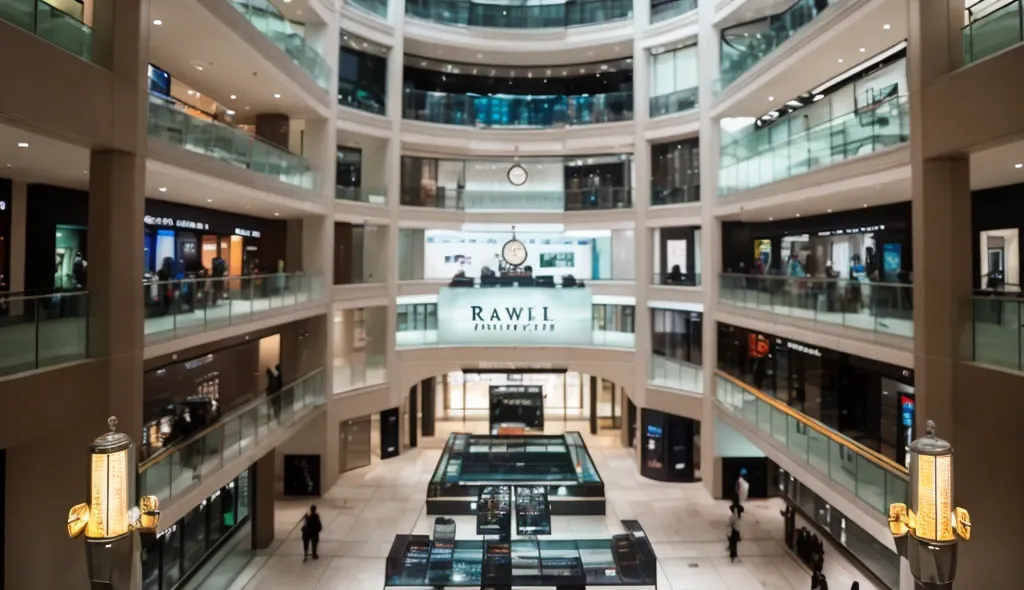
15. Baltimore Water Taxi
Important Information
- Address: Multiple boarding points in Inner Harbor.
- Best time to visit: Spring–fall for best weather.
- Distance to city center: Inner Harbor.
- Pricing: Day pass around $20; discounts for kids.
- Parking: Use nearby garages or meters.
- Accessibility: Some docks/boats accessible.
- Opening Hours: 10 a.m.–8 p.m. (seasonal).
- Closing Hours: Around 8 p.m.
- Discounts / Deals: Family passes, seasonal specials.
The Baltimore Water Taxi, launched in 1975, is the oldest continuously operating water taxi service in the United States. Its creation was part of the city’s broader plan to reclaim the Inner Harbor as a public space rather than an industrial zone. What began as a modest fleet of small boats has become a quintessential Baltimore experience, linking neighborhoods and attractions across the waterfront.
Historically, the water taxi reflects Baltimore’s maritime heritage. For centuries, the harbor was the city’s lifeline—where ships carried goods, immigrants, and innovations that shaped the region. The taxi system preserves that connection to the water, but in a way that’s recreational and accessible. Instead of labor and cargo, the harbor now ferries families, tourists, and commuters enjoying the city from a new perspective.
Gliding across the harbor today, riders see the blending of old and new—historic ships docked near modern skyscrapers, working piers beside cultural landmarks. In many ways, the water taxi is a living metaphor for Baltimore’s transformation: a working harbor reimagined as a civic playground, where history and leisure share the same waters.
16. Oriole Park at Camden Yards
Important Information
- Address: 333 W. Camden Street, Baltimore, MD 21201
- Best time to visit: Baseball season (April–September).
- Distance to city center: About 0.5 miles from Inner Harbor.
- Pricing: Tickets $15–$70+, depending on seat.
- Parking: Stadium lots and garages ($10–$20).
- Accessibility: Accessible seating and entrances.
- Opening Hours: Gates open 90 minutes before games.
- Closing Hours: After games, usually 10–11 p.m.
- Discounts / Deals: Student, family nights, and group discounts; memberships available.
When Oriole Park at Camden Yards opened in 1992, it revolutionized baseball stadium design across the United States. Built on a site once home to the Baltimore & Ohio Railroad’s Camden Station, the park preserved historic architecture—most notably the massive red-brick B&O warehouse that looms beyond right field—while introducing fan-friendly features that sparked a wave of “retro-classic” ballparks nationwide.
Baseball in Baltimore stretches back to the 19th century, with the city producing legends like Babe Ruth, who was born just a few blocks from Camden Yards. By blending modern amenities with historical character, Oriole Park reconnected the city to its baseball roots while setting a new standard for sports venues across the country.
For Baltimore, the stadium became more than a ballpark; it was a civic triumph, drawing millions downtown and restoring pride in the city’s sporting culture. Attending an Orioles game here means stepping into a place where history, architecture, and America’s pastime converge. It remains one of the most beloved ballparks in the nation—a jewel of both baseball history and Baltimore’s urban revival.
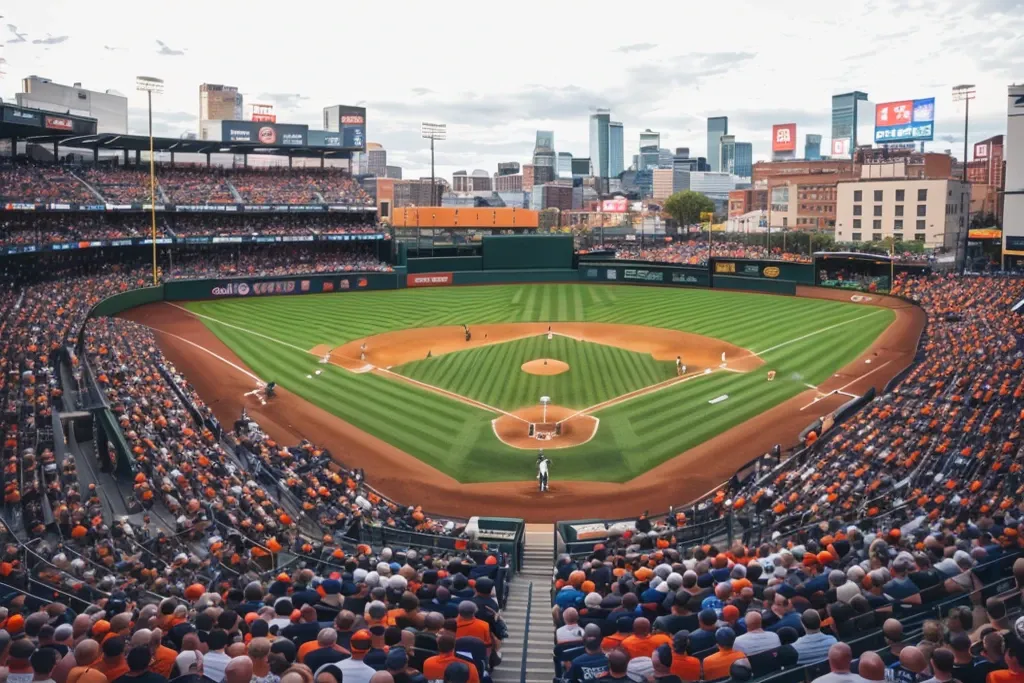
Interactive Map
Where to Eat In Inner Harbor
| # | Restaurant | Address (Google Maps) | Contact Info | Signature Dish / Specialty |
|---|---|---|---|---|
| 1 | Rusty Scupper | 402 Key Hwy, Baltimore, MD 21230 | (410) 727-3678 | Maryland crab cakes, seafood with sweeping harbor views |
| 2 | Phillips Seafood | 601 E Pratt St, Baltimore, MD 21202 | (410) 685-9090 | Famous family-recipe crab cakes, steamed seafood buckets |
| 3 | Blackwall Hitch | 201 E Pratt St, Baltimore, MD 21202 | (443) 759-7176 | Coastal dining, fresh seafood in nautical ambiance |
| 4 | Ammoora | 100 Ben Allen Blvd, Baltimore, MD 21202 (Ritz-Carlton Res.) | (410) 528-7700 | Levantine cuisine with modern Syrian flair |
| 5 | The Capital Grille | 801 Aliceanna St, Baltimore, MD 21202 | (410) 547-5600 | Dry-aged steaks, extensive wine list |
| 6 | McCormick & Schmick’s Seafood | 648 S President St, Baltimore, MD 21202 | (410) 649-9943 | Contemporary seafood & steaks, waterfront views |
How to Get to Inner Hrbor
By Car
Driving is one of the easiest ways to reach the Inner Harbor since it’s directly connected by major highways and has several parking garages nearby.
- From Washington, D.C.: About 1 hour via I-95 N (approx. 40 miles).
- From Philadelphia, PA: Roughly 1.5–2 hours via I-95 S (approx. 100 miles).
- From New York City, NY: Around 3.5–4 hours via I-95 S (approx. 190 miles).
- From Pittsburgh, PA: About 4.5–5 hours via I-70 E and I-76 E (approx. 250 miles).
Once you arrive, public parking garages such as Harbor Park Garage and Lockwood Garage are within walking distance of the waterfront.
By Air
- Baltimore/Washington International Thurgood Marshall Airport (BWI) is the closest airport, just 12 miles (about 20 minutes) from the Inner Harbor.
- From the airport, you can take:
- Light RailLink directly into downtown Baltimore (about 30 minutes).
- Taxi, Uber, or Lyft, typically 20–25 minutes depending on traffic.
- Rental cars are available at BWI’s consolidated rental facility.
By Train
- Amtrak runs frequent service to Baltimore Penn Station, which is only 2 miles from the Inner Harbor. From there, you can hop on a short taxi/ride-share (10 minutes) or take the Charm City Circulator Purple Line (free shuttle bus).
- MARC Train (Camden Line) connects Washington, D.C. to Baltimore Camden Station, which is just a 5–10 minute walk from the Inner Harbor.
By Bus
Several intercity bus services (Greyhound, Megabus, FlixBus) run routes into Baltimore. The Downtown Greyhound Station is about 1.5 miles from the Inner Harbor, easily accessible by rideshare or local bus.
Local Transportation
Once you’re in the city, the Inner Harbor is pedestrian-friendly. You can also use:
- Charm City Circulator (free bus service).
- Water Taxi for scenic travel across the harbor.
- Scooters and bikes (available for rent via mobile apps).
Conclusion
Baltimore’s Inner Harbor is far more than a tourist hub—it’s a living chapter of American history. What began as a working seaport in the 18th century evolved into an industrial powerhouse, and later into one of the nation’s most remarkable urban renewal success stories. Walking its waterfront today, you encounter echoes of every era: the proud tall ships that recall maritime glory, museums that honor both industry and art, and repurposed warehouses that hum with food, music, and creativity.
Each attraction tells a piece of Baltimore’s story. The National Aquarium reflects the city’s connection to the sea; Camden Yards celebrates both baseball and architectural preservation; and Harborplace marks the turning point when Baltimore proved that cities could reinvent their futures. Together, these sites capture the resilience and innovation that have long defined Baltimore and its people.
Karta has some amazing deals on Inner Harbor vacation rentals that will surely give you the cool chills of Baltimore, away from the crime-concern areas.
FAQ
1. Is Inner Harbor safe for tourists?
While Baltimore has areas with crime concerns like any other city, the Inner Harbor is generally considered safe for tourists, especially during daytime hours. The area is well-patrolled, and many attractions, shops, and restaurants are clustered close together, making it a popular and bustling area.
2. Can you swim in the Inner Harbor?
Swimming is not recommended in the Inner Harbor due to water quality issues and heavy maritime traffic. However, there are various other water Baltimore harbor activities available, like paddle boating and water taxi rides.
3. What are the parking options near Inner Harbor?
Inner Harbor has several parking garages and lots. There is also metered street parking available, although it may be difficult to find a spot during busy times. Many visitors opt to use public transportation or ride-sharing services to avoid parking hassles.
4. Are pets allowed in Inner Harbor attractions?
Pet policies vary by attraction. Some outdoor spaces like parks are pet-friendly, but most indoor attractions and museums do not allow pets. Service animals are generally an exception.
5. Is Inner Harbor wheelchair accessible?
Most of the Inner Harbor is wheelchair accessible, including major attractions like the National Aquarium and Maryland Science Center. Many restaurants and shops are also accessible, but it's always best to check in advance.
6. What are the best times to visit Inner Harbor?
While the Inner Harbor is a year-round destination, spring and fall offer the most pleasant weather for outdoor activities. Summer can be hot and humid but provides a lot of outdoor festivals and events. Winter is quieter but has its own charm, especially around the holidays.
7. Are there any free attractions in Inner Harbor?
Federal Hill Park offers a great view of the harbor and is free to visit. The Inner Harbor itself is a public space with street performers, public art, and lots of space to people-watch or enjoy a packed meal.
8. Is it possible to visit multiple attractions in one day?
Yes, one of the advantages of the Inner Harbor is the proximity of its attractions. It's entirely possible to visit the National Aquarium, take a water taxi ride, and catch an Orioles game all in one day, for example.
9. Can you fish in the Inner Harbor?
Fishing is generally not allowed in the Inner Harbor due to water quality concerns and local regulations.
10. What are some must-try local foods in the area?
Baltimore is famous for its crab cakes, and you'll find plenty of seafood options around the Inner Harbor. Other local favorites include pit beef sandwiches and Berger Cookies.


